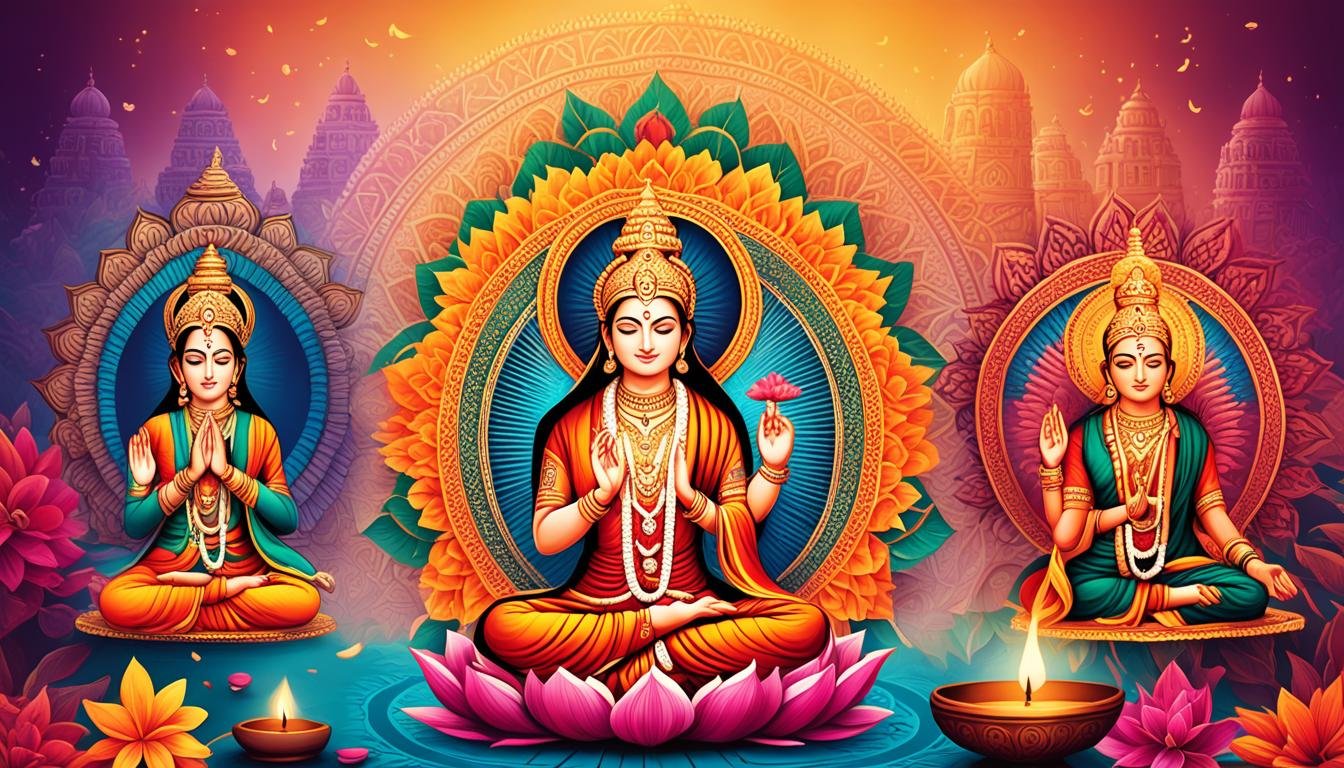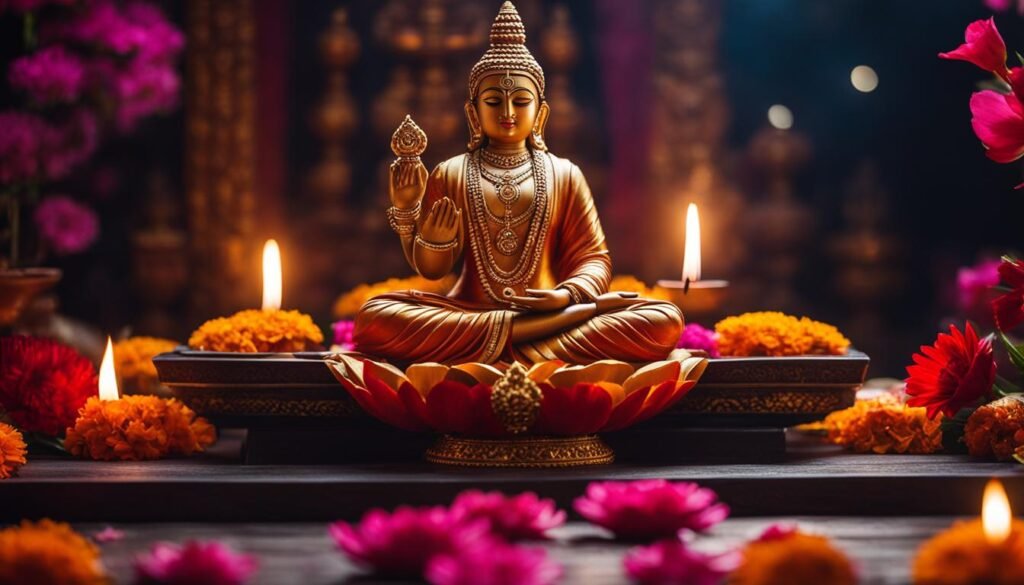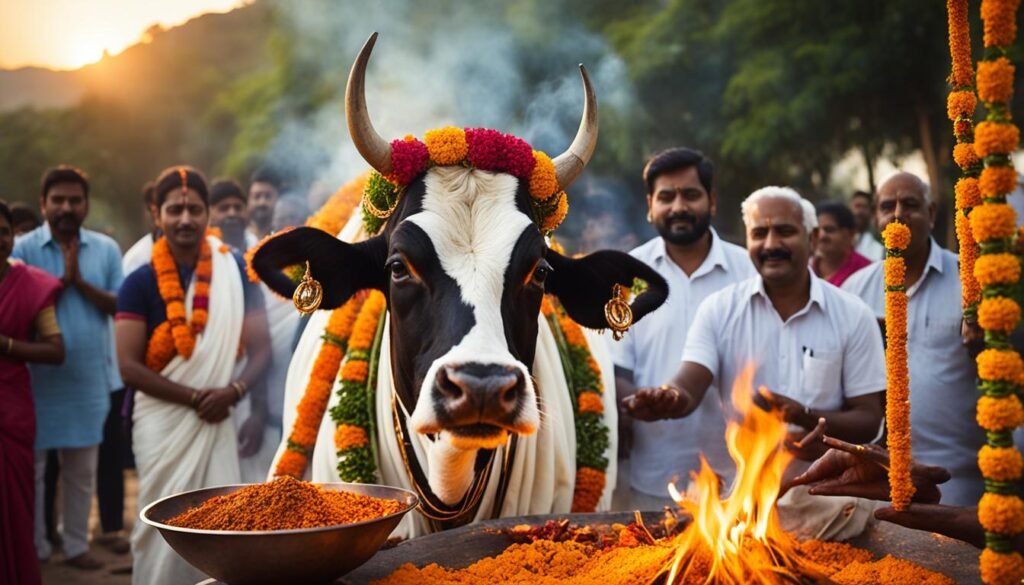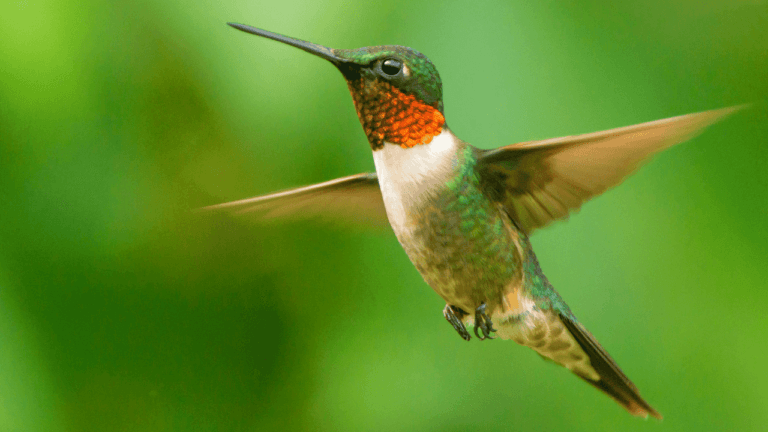Hindu Prayer Methods Divine Dialogues The Art of Hindu Prayer

Welcome to “Divine Dialogues: The Art of Hindu Prayer.” In this series, we explore the intricacies of Hindu prayer methods, providing insights into the techniques and worship methods practiced by millions around the world. Prayer holds a special place in Hinduism, serving as a direct channel for communication with the Divine. Through various practices such as chanting mantras and performing rituals, Hindus seek to establish a profound connection with the divine presence.
Throughout this journey, we will delve into the diverse facets of Hindu prayer, exploring its significance, techniques, and spiritual practices. From the chanting of mantras and meditation to the devotional practice of Bhakti Yoga and the worship rituals of Puja, each section will shed light on different aspects of Hindu prayer methods. We will also explore the importance of rituals, symbols, sacred spaces, and sacred times in Hindu worship.
Key Takeaways:
- Hindu prayer methods enable direct communication with the Divine.
- Chanting mantras and meditation are essential practices in Hindu prayer methods.
- Bhakti Yoga emphasizes love and devotion to the Divine.
- Puja is a form of worship involving offerings and rituals.
- Rituals, symbols, and sacred spaces play crucial roles in Hindu prayer methods.
Hindu Mantras: Unlocking the Power of Prayer
Mantras have long been a cornerstone of Hindu prayer, cherished for their ability to unlock profound spiritual experiences. Chanting these sacred sounds has a transformative effect on the mind and soul, invoking the divine presence and fostering a deep connection with the spiritual realm.
Hindu mantra chanting involves the repetition of specific phrases or syllables, each carrying its own vibrational energy and spiritual significance. The rhythmic recitation of mantras helps to still the mind, bringing focus and clarity to the practitioner. Through the power of sound, mantras create a harmonious resonance within the individual, enabling them to transcend the limitations of ordinary consciousness.
These ancient chants are not mere words, but potent spiritual tools that open doorways to higher realms of consciousness. By repeating mantras, one can attune themselves to the divine frequencies and invoke the blessings of the gods and goddesses worshipped in the Hindu tradition.
“Om Namah Shivaya”, the mantra dedicated to Lord Shiva, is one of the most popular mantras in Hinduism. Chanting this sacred sound is believed to bring inner peace, protection, and spiritual awakening.
Hindu meditation methods often incorporate the chanting of mantras to deepen the meditative experience. By focusing on the sound vibrations and the subtle sensations they create within the body, meditators can enter a state of deep relaxation, inner peace, and heightened awareness.
Moreover, Hindu rituals and ceremonies, such as puja (worship), are accompanied by the rhythmic recitation of mantras. As devotees offer prayers to the deities, the mantras serve as a vehicle to express reverence and gratitude. The melodic repetition of these ancient sounds creates an atmosphere of spiritual devotion and fosters a profound connection with the divine.
Additionally, the power of mantras extends beyond individual spiritual practice. They are often recited collectively during Hindu ceremonies and celebrations, creating a collective energy field that uplifts and purifies the entire gathering.
Meditation is another essential aspect of Hindu spiritual practice. Through various techniques such as breath-focused meditation, mantra repetition, or visualization, individuals can cultivate inner stillness and expand their consciousness. Hindu meditation methods enable seekers to explore their inner depths, connect with their true selves, and experience the profound peace and bliss that lies within.
Benefits of Hindu Mantra Chanting and Meditation:
- Enhances focus and concentration
- Reduces stress and anxiety
- Improves mental and emotional well-being
- Deepens spiritual connection
- Aids in self-discovery and personal transformation
- Purifies and balances the energy body
- Cultivates inner peace and tranquility
By embracing the power of mantra chanting and meditation, individuals can unlock the transformative potential of their own minds and hearts. These ancient practices offer a gateway to higher consciousness, paving the way for spiritual growth, self-realization, and profound inner peace.
| Hindu Mantra | Meaning |
|---|---|
| “Om” | The primordial sound, representing the essence of existence |
| “Gayatri Mantra” | A universal prayer for spiritual enlightenment and divine wisdom |
| “Om Shanti” | Invocation of peace and harmony |
| “Om Namah Shivaya” | Dedicated to Lord Shiva, represents surrender and devotion |
| “Hare Krishna, Hare Rama” | Devotional mantra invoking the divine presence |
| “Om Gam Ganapataye Namaha” | Invokes the blessings and removal of obstacles by Lord Ganesha |
The Devotional Practice of Bhakti Yoga
Bhakti yoga is a deeply profound and heartfelt devotional practice in Hinduism that centers around love and devotion to the divine. It encourages individuals to offer prayers, perform sacred rituals, and surrender themselves to God with unwavering faith and devotion. Through Bhakti yoga, devotees seek to develop a profound connection and a personal relationship with the divine presence.
One of the key aspects of Bhakti yoga is the observance of rituals, known as bhakti rituals, which serve as a means of expressing and deepening one’s devotion. These rituals can take various forms, with the most common being puja and arati. Puja involves the offering of flowers, fruits, incense, and other sacred items to the deities, accompanied by the recitation of prayers and mantras. Arati, on the other hand, is a ritual in which a lamp with a burning flame is waved in front of the deity, accompanied by the singing of devotional hymns.
Bhakti yoga also places great emphasis on the power of devotional chants and songs, known as bhajans and kirtans. These melodious expressions of devotion have the ability to uplift the spirit, evoke a deep sense of peace, and create an intimate connection with the divine. It is believed that through the repetition of sacred mantras and the singing of devotional songs, the mind becomes purified, allowing individuals to experience a profound spiritual awakening.
The practice of Bhakti yoga encourages individuals to cultivate a sense of surrender and complete devotion to God. It teaches that true devotion transcends external rituals and ceremonies, emphasizing the importance of a genuine and sincere heart. It is through this unwavering devotion that one can experience the boundless love and grace of the divine.
The Essence of Bhakti Yoga
Bhakti yoga brings together the individual and the divine in a beautiful dance of love and devotion. It is a path that allows for the expression of the deepest emotions and the opening of the heart to the divine presence. Through this practice, devotees can experience a sense of oneness, unity, and connection with the divine that transcends the boundaries of the physical realm.
“Bhakti is the path of love. Through love, one can reach God.”
By engaging in the devotional practice of Bhakti yoga, individuals can nurture their spiritual growth, find solace in the divine, and experience the transformative power of devotion. It is a path that serves as a reminder of the eternal love that resides within each being and invites practitioners to embrace the divine within themselves and others.
| Bhakti Rituals | Description |
|---|---|
| Puja | Offering of prayers, flowers, fruits, incense, and other sacred items to the deities |
| Arati | Ritual of waving a lamp in front of the deity accompanied by the singing of devotional hymns |
| Bhajans and Kirtans | Singing of devotional songs and chants to evoke a deep sense of devotion and connection with the divine |
The Art of Puja: Worshiping the Divine
Puja, a fundamental aspect of Hindu worship, is a sacred ritual that allows devotees to connect directly with the divine. Whether performed in the serene setting of a temple or within the sanctity of one’s home, puja is an expression of reverence, gratitude, and devotion to the deities. Through rituals, songs, and prayers, Hindus engage in this spiritual practice to seek blessings and establish a profound connection with the divine presence.
“Puja is not just an act of external worship; it is a profound inward journey, a communion between the devotee and the divine.”
The Rituals of Puja
During puja, a series of rituals are meticulously performed to create a sacred atmosphere and honor the deities. Offerings of water, fruit, flowers, and incense are made to symbolize purity, nourishment, beauty, and divine presence. The use of sacred objects, such as aarti lamps, conch shells, and bells, adds to the ceremonial ambiance. The precise steps and practices of puja may vary depending on regional customs, traditions, and the specific deity being worshipped.
A typical puja ceremony involves the following rituals:
- Invocation: The ceremony begins with the invocation of the deities, inviting their divine presence.
- Bathing and Dressing: The idols or images of the deities are bathed and adorned with beautiful clothing and jewelry.
- Offerings: Devotees make offerings of water, flowers, fruits, sweets, and incense to the deities.
- Mantra Chanting: Recitation of sacred chants and mantras is an integral part of puja, enhancing spiritual focus and invoking divine blessings.
- Arati: Aarti is the waving of a lit lamp in front of the deities, accompanied by devotional hymns, symbolizing the illumination of inner light.
- Prasad: Devotees receive prasad, a blessed offering, which is distributed as a symbol of divine grace and blessings.
Puja is not merely a scripted set of actions but a heartfelt expression of devotion, with each gesture and offering conveying a deep spiritual significance. Through these rituals, Hindus believe they can establish a personal connection with the divine, seek guidance, and experience the presence of God in their lives.
The Significance of Rituals and Symbols
In Hindu prayer, rituals and symbols hold great significance, representing profound spiritual meaning and connecting worshippers to the divine. One notable ritual is the yagna and havan ceremony, where sacred substances are offered into a sacred fire. This act symbolizes the purification of the mind, body, and soul, fostering positive energy, blessings, and spiritual upliftment.
Another essential aspect of Hindu prayer is the observance of various rituals that deepen devotion and foster a connection with the divine. For instance, tying of sacred threads, known as rakhi, is a ritual that symbolizes the bond between siblings and invokes the blessings of protection. Wearing sacred markings, such as the tilak on the forehead, is a practice that signifies devotion and identification with a particular deity.
“Rituals and symbols are the language of the divine, allowing us to express our reverence, devotion, and spiritual connection.” – Hindu Spiritual Teacher
Through the profound symbolism of rituals and the adornment of sacred symbols, Hindus express their devotion, gratitude, and yearning for spiritual connection. These practices are deeply rooted in the rich cultural and spiritual tapestry of Hinduism, embodying the cosmic energies and divine presence worshipped by millions.
As the image below illustrates, the yagna and havan ceremony is a visually captivating and spiritually uplifting ritual that encompasses Hindu prayer. The alt attribute of the image is “Hindu yagna and havan ceremony”.
The Power of Symbolism
Symbolism is an integral part of Hindu rituals and ceremonies, adding depth and meaning to the act of worship. Each symbol used in prayer carries significance and represents different aspects of the divine. For instance, the lotus flower symbolizes purity and spiritual enlightenment, while the sacred cow represents abundance and nurturing energy.
The use of symbolic gestures, known as mudras, also holds great importance. Mudras involve the positioning of fingers and hands in specific forms to direct energy flow and invoke the divine presence. Each mudra has a unique purpose, such as promoting focus, calming the mind, or expressing reverence.
Hindu rituals and symbols act as powerful bridges between the physical and spiritual realms, forging a deeper connection with the divine and allowing worshippers to experience the transformative power of prayer.
| Symbol | Meaning |
|---|---|
| Lotus Flower | Symbolizes purity and spiritual enlightenment |
| Sacred Cow | Represents abundance and nurturing energy |
| Aum Symbol | Embodies the sacred sound of creation and the supreme cosmic reality |
Sacred Spaces and Sacred Times
Hindus believe that certain places and times are more conducive to prayer and connection with the divine. Hindu temples serve as sacred spaces where devotees gather to worship and offer prayers to the deities. These temples are not only places of religious significance but also architectural marvels, adorned with intricate carvings and beautiful sculptures that depict various Hindu deities and mythological stories. The ambiance of a Hindu temple creates a serene and spiritual atmosphere, allowing devotees to immerse themselves in devotion and seek divine blessings.
Temple rituals are performed by trained priests who strictly follow traditional practices and protocols. These rituals provide a structured framework for prayer and worship, ensuring that every aspect of the ceremony is performed with utmost reverence and devotion. The main deity of the temple is worshipped through elaborate rituals, which may include the offering of flowers, incense, camphor, and food, along with the chanting of sacred hymns and mantras.
Besides temples, natural spaces are also considered sacred in Hinduism. Rivers, mountains, and forests hold great spiritual significance and are believed to be the abodes of various gods and goddesses. Pilgrimages to these holy sites are undertaken by millions of devotees each year, seeking spiritual purification and blessings.
In addition to sacred spaces, specific times and occasions hold great importance in Hinduism. Ceremonies and festivals play a vital role in Hindu prayer and worship, providing devotees with dedicated opportunities to express their devotion, celebrate their faith, and connect with the divine. These occasions are marked by elaborate rituals, devotional singing, and other forms of worship.
Major Hindu Festivals
- Diwali – The Festival of Lights
- Holi – The Festival of Colors
- Shivaratri – The Night of Lord Shiva
- Navaratri – The Nine Nights of Goddess Durga
Benefits of Praying in Sacred Spaces and at Sacred Times
- Enhanced spiritual experience
- Inspiration and motivation for devotion
- Opportunity to connect with a community of like-minded individuals
- Exposure to cultural and religious traditions
- Experience of divine presence and blessings
Praying in Hindu temples and participating in ceremonies and festivals not only strengthens one’s connection with the divine but also promotes a sense of unity and harmony within the community. It allows individuals to experience the rich cultural and spiritual heritage of Hinduism firsthand, fostering a deep sense of pride and belonging.
Next, we will explore the significance of rituals and symbols in Hindu prayer, delving into the practices of yagna and havan ceremonies.
Conclusion
Hindu prayer methods encompass a wide range of practices, including mantra chanting, meditation, rituals, and ceremonies. These methods provide a profound means for Hindus to connect with the divine and seek blessings, guidance, and spiritual growth.
Prayer holds a deeply personal and meaningful significance for Hindus. Through prayer, individuals strive to cultivate love, devotion, and a sense of unity with the divine presence. It serves as a sacred journey that embraces the spiritual essence of devotional practices, leading to inner peace and spiritual fulfillment.
Whether it is the rhythmic recitation of mantras, the stillness and introspection found in meditation, the participation in rituals, or the active engagement in ceremonies, Hindu prayer methods offer a direct channel for communication with the divine and an opportunity to deepen one’s spiritual connection.
By embracing these sacred practices, Hindus not only maintain their faith but also nourish their souls, finding solace, guidance, and a sense of purpose in their lives. Hindu prayer methods embody the rich tapestry of Hindu spiritual practices and continue to be a cornerstone of worship, reverence, and devotion in the Hindu tradition.














